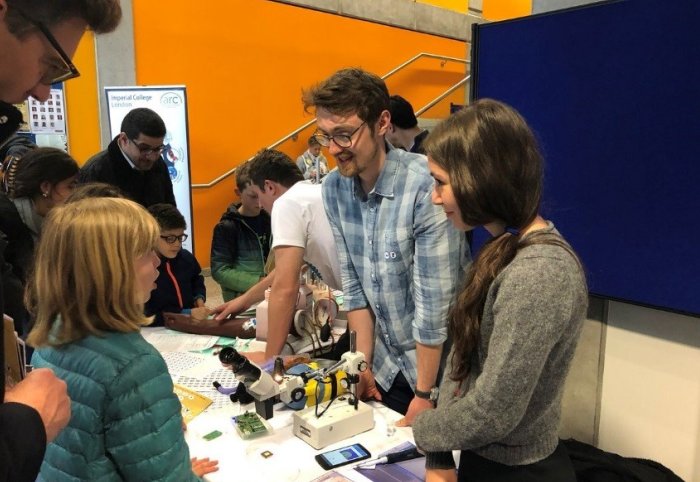Serendipity and Mars tremors at the Imperial Festival!
by Kay Hancox

What do microchip technologies to diagnose disease, drones delivering packages, serendipity in innovation and sensing tremors on Mars have in common?
They are all examples of research from Department of Electrical and Electronic Engineering that was shared with the public at the Imperial Festival on 26-27 April 2018.
The Sense and Serendipity stand highlighted two final year undergraduate projects. Sharlyn Doshi is investigating techniques that encourage serendipity in Human-Computer Interaction. Many great discoveries in science and engineering have come about by accident: the microwave oven, penicillin, Velcro, even chocolate chip cookies! Sharlyn’s project aims to establish the optimum psychological and environmental conditions for serendipitous discovery. Festival attendees took tests to see what they saw in various optical illusions. Joshua Brown’s ‘Tactile Mouse’ gives visually impaired people access to printed media such as photographs, maps and magazines by way of a handheld device that can read text and colour on a surface and create an intuitive, tactile representation. When finished, this device will give the visually-impaired independence to access material that was previously beyond their reach. The public response to the project was overwhelmingly positive, with Festival goers eager to see the device developed further as a commercial product.

Over 700 people enjoyed the highly interactive crane and tilt-rotor aircraft control exhibit which showed how software and algorithms can be used to interact with the real world in real-time. Visitors were given the chance to manually control an overhead gantry crane through a maze and to land a laboratory scale tilt-rotor aircraft. Inevitably, this resulted in many broken mazes and crashed aircraft! An underlying computer control algorithm was then activated. These algorithms visibly stabilized the crane and tilt-rotor craft, allowing visitors of all ages to perform complex manoeuvres. Remarkably, the same simple underlying algorithm was used for control of both the crane and the aircraft – two very different systems.

Researchers from the Department’s Centre for Bio-Inspired Technology (CBIT) demonstrated a new mobile platform that using microchip technology is able to diagnose infectious diseases such as malaria and dengue. Throughout the two-day event hundreds of people interacted with the demo where they were they could see understand the tiny scale of microelectronics by observing the chip through the microscope. They were then able to test the chip’s diagnostics to see how it could be used to monitor health and diagnose infectious diseases by applying a small blood sample to the chip and getting results back in less than 30 minutes through an app on their phone. With the first clinical trials coming in the summer, and the positive response and the user feedback received at the festival, Dr Georgiou and his team are very excited about how this technology will revolutionise diagnostics for infectious diseases!

In the very popular Robot Zone, Dr Bouganis and Alexandros Kouris challenged visitors to control a drone and deliver a package. This demonstrated how various computing technologies come together to make a small drone fly. Discussion with visitors centred around the challenges that need to be addressed in order to have fully autonomous drones that can navigate in unknown environment by estimating their position and the structure of the environment, and how high-performance embedded computing, and in particular FPGAs, can help towards this direction. Alexandros Kouris was interviewed by Stuart Higgins SciNotSci podcast on the day in the life of a drone engineering where he confessed that the “first machine I switch on is the coffee machine”.
Mrs Esther Perea, our Senior Tutor, and a team of assistants had a range of toys that had been entered into the Science Toy Award for young visitors to play with – their reactions contributed to the judging panel’s final decisions.
Professor Tom Pike spoke to an audience of over 300. He explained how listening to Martian tremors could help us understand Mars’s past habitability for life and why our solar system neighbour turned out so different from earth. He demonstrated the microseismometers that he and his team developed. The microseismeters are about the size of a £1 coin and form part of the Marsquake detection instrument that will be launched later this week as part NASA Mars Insight mission.
Imperial College’s Alumni Weekend ran alongside the Festival. On Saturday afternoon around 30 alumni returned to the Department. Despite having graduated over a 55 year period - between 1961-2017 - they bonded over wine, and displays of old electrical equipment: the Avo meter was a particular draw. Professor Eric Yeatman, Head of Department, gave a short talk and then faced up to some challenging questions from our guests. Around 10 alumni finished their visit with a tour of the Department. All were able to vividly recall where they used to sit in the main lecture theatre. A stop in the electrical teaching laboratory led to many alarming tales about experiments which mainly seemed to involve dropping objects from a great height or firing metal plates at great speed.

Article text (excluding photos or graphics) © Imperial College London.
Photos and graphics subject to third party copyright used with permission or © Imperial College London.
Reporter
Kay Hancox
Department of Electrical and Electronic Engineering